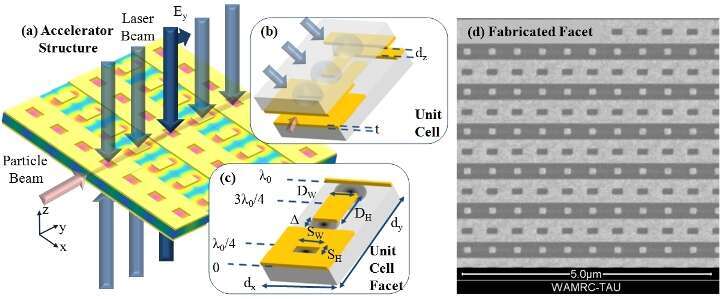
Efficient Particle Acceleration using Plasmonic Metasurfaces
The use of plasmonic metasurfaces for enhancing optical phenomena and applications was studied extensively in the last decade. These structures can focus electro-magnetic energy into an ultra-small volume, resulting in a large enhancement of the local field. Furthermore, the field amplitude, phase and polarization in their vicinity can be controlled as desired [1].
Laser-driven particle accelerators hold promise for high-energy physics, radiation generation, medicine and more. Due to its transverse nature, the electric field of a laser pulse co-propagating with the particles cannot be utilized for their acceleration. Consequently, several techniques have been suggested to rotate the field and gain a synchronized component that can be used. Nonetheless, most of them are not very efficient for ultra-short pulse lasers utilization, which are attractive for acceleration applications due to very large electric fields they attain. The most efficient structure presented for this purpose consisted of a periodic dielectric structure [2]. Dielectric structures were considered favorable over metallic structures due to metallic losses at optical wavelengths. However, the field enhancement in plasmonic metasurfaces can be utilized for compensating these losses and attaining a substantial acceleration.
Here, we show that plasmonic metasurfaces can realize efficient accelerators. Using a periodic nanoantenna structure consisting of a unique slot-patch unit cell (see figure) we manipulate the field profile such that it yields efficient acceleration, almost four times larger than contemporary short-pulse schemes [3]. The structure is optimized for accelerating relativistic particles using an 800nm laser, potentially reaching an acceleration gradient of 11.6GV/m. The design versatility, the efficient ultra-short pulse operation and the high acceleration gradient, render this structure a promising concept for future laser accelerators operating at the ultra-short pulse regime.

[1] N. Yu et al., IEEE J. Sel. Top. Quantum Electron. 19, 4700423 (2013).
[2] E. A. Peralta et al., Nature 503, 91 (2013).
[3] D. Bar-Lev and J. Scheuer, Phys. Rev. ST Accel. Beams 17, 121302 (2014).
dbmm64@gmail.com
Powered by Eventact EMS